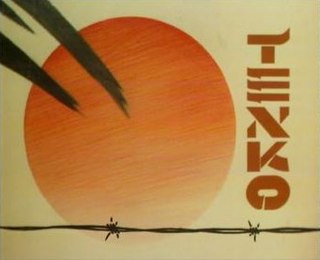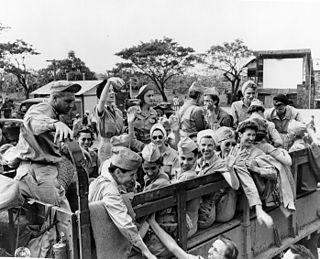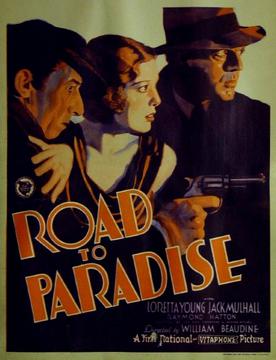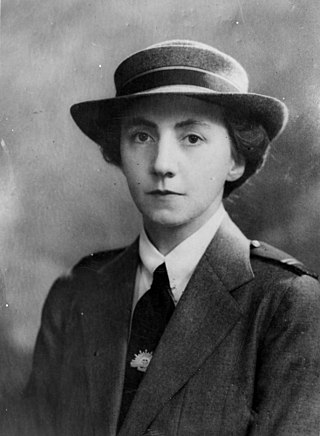
Catherine Elise Blanchett is an Australian actor and producer. Regarded as one of the best performers of her generation, she is recognised for her versatile work across independent films, blockbusters and the stage. She has received numerous accolades, including two Academy Awards, four British Academy Film Awards and four Golden Globe Awards, in addition to nominations for two Primetime Emmy Awards and a Tony Award.

A Town Like Alice is a romance novel by Nevil Shute, published in 1950 when Shute had newly settled in Australia. Jean Paget, a young Englishwoman, becomes romantically interested in a fellow prisoner of World War II in Malaya, and after liberation emigrates to Australia to be with him, where she attempts, by investing her substantial financial inheritance, to generate economic prosperity in a small outback community—to turn it into "a town like Alice" i.e. Alice Springs.

Tenko is a television drama series co-produced by the BBC and the Australian Broadcasting Corporation (ABC), which was broadcast between 1981 and 1985.

Lieutenant Colonel Vivian Statham, was an Australian Army nurse during the Second World War. She was the sole surviving nurse of the Bangka Island Massacre, when the Japanese killed 21 of her fellow nurses on Radji Beach, Bangka Island, in the Dutch East Indies on 16 February 1942.

The Bangka Island massacre was the killing of unarmed Australian nurses and wounded Allied soldiers on Bangka Island, east of Sumatra in the Indonesian archipelago on 16 February 1942. Shortly after the outbreak of World War II in the Pacific troops of the Imperial Japanese Army murdered 22 Australian Army nurses, 60 Australian and British soldiers, and crew members from the Vyner Brooke. The group were the only survivors from their steamship which had been sunk by Japanese bombers just after the defeat of Singapore. After surrendering to local Japanese forces on Bangka Island, which was then part of the Dutch East Indies, the group and its wounded were taken to a beach where they were killed by being bayonetted and machine gunned in the surf. Only South Australian nurse Sister Lieutenant Vivian Bullwinkel, American Eric Germann and Royal Navy Stoker Ernest Lloyd survived.

A hell ship is a ship with extremely inhumane living conditions or with a reputation for cruelty among the crew. It now generally refers to the ships used by the Imperial Japanese Navy and Imperial Japanese Army to transport Allied prisoners of war (POWs) and rōmusha out of the Philippines, the Dutch East Indies, Hong Kong and Singapore in World War II. These POWs were taken to the Japanese Islands, Formosa, Manchukuo, Korea, the Moluccas, Sumatra, Burma, or Siam to be used as forced labor.

Agnes Betty Jeffrey, OAM was an Australian writer who wrote about her Second World War nursing experiences in the book White Coolies.
Jesse Rosenfeld is an Australian stage, television and film actor, best known for playing Marco Silvani on the soap opera Neighbours.
SS Rooseboom was a 1,035 ton Dutch steamship owned by KPM (Koninklijke Paketvaart-Maatschappij of the Netherlands East Indies built in 1926 by Rijkee & Co of Rotterdam, the Netherlands.
Margaret Dryburgh was an English teacher and missionary. Born in Sunderland, England, she later became a missionary in Singapore, where she was captured in the Second World War. The plight of Dryburgh and her fellow inmates such as Betty Jeffrey in a Japanese prisoner of war camp inspired the 1996 film Paradise Road. She wrote The Captives' Hymn while imprisoned.

The Angels of Bataan were the members of the United States Army Nurse Corps and the United States Navy Nurse Corps who were stationed in the Philippines at the outset of the Pacific War and served during the Battle of the Philippines (1941–1942). When Bataan and Corregidor fell, 11 navy nurses, 66 army nurses, and 1 nurse-anesthetist were captured and imprisoned in and around Manila. They continued to serve as a nursing unit while prisoners of war. After years of hardship, they were finally liberated in February 1945.
The 5th St. Louis Gateway Film Critics Association Awards were awarded on December 15, 2008.

Antonie Hendrikus Colijn was a Dutch amateur mountaineer who in 1936 led the Carstensz Expedition, being the first to climb the Carstenszgebergte in New Guinea.

A Town Like Alice is a 1956 British drama film produced by Joseph Janni and starring Virginia McKenna and Peter Finch that is based on the 1950 novel of the same name by Nevil Shute. The film does not follow the whole novel, concluding at the end of part two and truncating or omitting much detail. It was partially filmed in Malaya and Australia.

Road to Paradise is a 1930 American pre-Code drama film produced and distributed by First National Pictures, and starring Loretta Young, Jack Mulhall and Raymond Hatton. It was directed by William Beaudine and is based on a 1920 play Dodson Mitchell by Zelda Sears called Cornered. The film was a remake of a 1924 silent version, entitled Cornered, which was also directed by William Beaudine.

The Women's Vocal Orchestra of Sumatra (1943-1944) was a choral group founded in a Japanese prisoner of war camp in Sumatra during World War II.
Susan Kathleen Milliken is an Australian film producer and author.

Olive Dorothy Paschke, RRC was a distinguished Australian army nurse who died in the Second World War.
Norah Chambers was a British chorale conductor.













